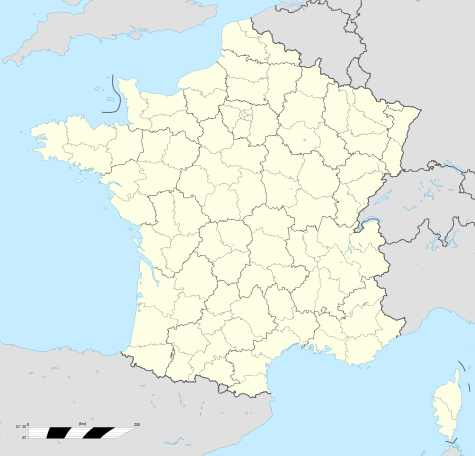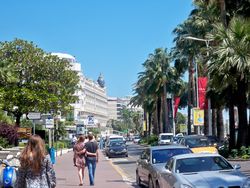Cannes
|
Cannes |
|
| Cannes France.jpg | |
 Cannes
|
|
| Administration | |
|---|---|
| Country | France |
| Region | Provence-Alpes-Côte d'Azur |
| Department | Alpes-Maritimes |
| Arrondissement | Grasse |
| Mayor | Bernard Brochand (2008–2014) |
| Statistics | |
| Elevation | 0–260 m (0–850 ft) |
| Land area1 | 19.62 km2 (7.58 sq mi) |
| Population2 | 71,790 (2006) |
| - Density | 3,659 /km2 (9,480 /sq mi) |
| INSEE/Postal code | 06029/ 06400 |
| 1 French Land Register data, which excludes lakes, ponds, glaciers > 1 km² (0.386 sq mi or 247 acres) and river estuaries. | |
| 2 Population sans doubles comptes: residents of multiple communes (e.g., students and military personnel) only counted once. | |
Cannes (French pronunciation: [kan], in Occitan Canas) is one of the best-known cities of the French Riviera, a busy tourist destination and host of the annual Cannes Film Festival. It is a Communes of France in the Alpes-Maritimes department.
The city is also famous for its various luxury shops, restaurants, and hotels.
Contents |
History
By the 2nd century BC the Ligurian Oxybii established a settlement here known as Aegitna. Historians are unsure what the name means. The area was a fishing village used as a port of call between the Lérins Islands.

In 69 AD it became the scene of violent conflict between the troops of Othos and Vitellius.[1]
Cannes: the name
In the 10th century the town was known as Canua. The name may derive from "canna", a reed. Canua was probably the site of a small Ligurian port, and later a Roman outpost on Le Suquet hill, suggested by Roman tombs discovered here. Le Suquet housed an 11th-century tower which overlooked swamps where the city now stands. Most of the ancient activity, especially protection, was on the Lérins islands and the history of Cannes is the history of the islands.
The birth of the "Suquet"
An attack by the Saracens in 891, who remained until the end of the 10th century, devastated the country around Canua. The insecurity of the Lérins islands forced the monks to settle on the mainland, at the Suquet. Construction of a castle in 1035 fortified the city by then known as Cannes, and at the end of the 11th century construction was started on two towers on the Lérins islands. One took a century to build; the other, three.
Around 1530, Cannes detached from the monks who had controlled the city for hundreds of years and became independent.
The Lérins islands (Les îles de Lérins)
During the 18th century, the Spanish and British both tried to gain control of the Lérins Islands, but were chased away by the French. The islands were later controlled by many, such as Jean-Honoré Alziary, and the Bishop of Fréjus. The islands had many different purposes; at the end of the 19th century, one was a hospital for soldiers in the Crimean War.
The Belle Époque (Beautiful Era)
Henry Brougham, 1st Baron Brougham and Vaux bought land at the Croix des Gardes and constructed the villa Eleonore-Louise. His work to improve living conditions attracted the English aristocracy, who also built winter residences.
At the end of the 19th century, several railways were completed. This prompted the arrival of streetcars. In Cannes, projects such as the Boulevard Carnot, the rue d'Antibes and the Carlton Hotel on the Promenade de la Croisette were carried out. After the closure of the Casino des Fleurs (hôtel Gallia), a luxury establishment was built for the rich winter clientèle; the Casino Municipal next to the pier Albert-Edouard. This casino was demolished and replaced by the new Palace in 1979.
Modern times
With the 20th century came new luxury hotels such as the Miramar and the Martinez. The city was modernised with a sports centre, street cars, a post office, and schools. There were fewer British and German tourists after the First World War but more Americans. Winter tourism gave way to summer tourism and the summer casino at the Palm Beach was constructed.
The city council had the idea of an international film festival shortly before World War II. The first opened on 20 September 1946, held in the Casino Municipal.
Climate
The climate is Mediterranean and the city enjoys 12 hours of sunshine per day during summer (May to September), while in winter (December to February) the weather is mild. Both seasons see a relatively low rainfall and most rain is during October and November, when 110 mm falls.
Summer
Cannes summers are long and warm, with summer daytime temperatures regularly hitting 30°C, while average temperatures are about 25°C. Temperatures remain high from June to September, the busiest time of the year. Despite the hot daytime temperatures, a Mediterranean breeze keeps summer evenings comfortably cool.
Winters
Temperatures drop below 10°C for only three months of the year (December to February). The spring and autumn are also warm, although more suited to those who prefer slightly cooler weather.
| Climate data for Cannes | |||||||||||||
|---|---|---|---|---|---|---|---|---|---|---|---|---|---|
| Month | Jan | Feb | Mar | Apr | May | Jun | Jul | Aug | Sep | Oct | Nov | Dec | Year |
| Source: infoclimat.fr[2] | |||||||||||||


Cityscape
La Croisette is the waterfront avenue with palm trees. La Croisette is known for picturesque beaches and for restaurants, cafés and boutiques. La Suquet, the old town, provides a good view of La Croisette. The fortified tower and Chapel of St Anne house the Musée de la Castre. The Man in the Iron Mask was imprisoned on the Île Sainte-Marguerite.
Museums
The Musée d'Art et d'Histoire de Provence houses artifacts from prehistoric to present, in an 18th century mansion. The Musée de la Castre has objects from the Pacific Atolls, Peruvian relics and Mayan pottery. Other venues include the Musée de la Marine, Musée de la Mer, Musée de la Photographie and Musée International de la Parfumerie.
The villas of Cannes
Nineteenth-century Cannes can still be seen in its grand villas, built to reflect the wealth and standing of their owners and inspired by anything from medieval castles to Roman villas. Lord Brougham’s Italianate Villa Eléonore Louise (one of the first in Cannes) was built between 1835 and 1839. Also known as the Quartier des Anglais, this is the oldest residential area in Cannes. Another landmark is the Villa Fiésole (known today as the Villa Domergue) designed by Jean-Gabriel Domergue in the style of Fiesole, near Florence. The villas are not open to the public. Villa Domergue may be visited on appointment.
Île Sainte-Marguerite (St Marguerite Island)
It took "The Man in the Iron Mask" 11 years to leave this tiny, forested island. The mysterious individual was believed to be of noble blood, but his identity has never been proven. His cell can be visited in the Fort of St Marguerite, now renamed the Musée de la Mer (Museum of the Sea). This museum also houses discoveries from shipwrecks off the island, including Roman (first century BC) and Saracen (10th century AD) ceramics.
Île Saint-Honorat (St Honorat Island)
Cistercian monks are the only inhabitants of the smaller, southern St Honorat Island. Monks have inhabited the island since AD410 and, at the height of their powers, owned Cannes, Mougins and Vallauris. Medieval vestiges remain in the stark church, which is open to the public, and in the ruins of the 11th-century monastery on the sea’s edge. The monks divide their time between prayer and producing red and white wines.
Theater and music
Cannes is not renowned for traditional theatre. However, small venues stage productions and host short sketches during the annual International Actors’ Performance Festival. Popular theaters include the Espace Miramar and the Alexandre III.
Economy

The area around Cannes has developed into a high-tech cluster. The technopolis of Sophia Antipolis lies in the hills beyond Cannes. The Film Festival is a major event for the industry. There is an annual television festival in the last week in September.
Festivals and show events
- The Cannes Film Festival (French: le Festival international du film de Cannes or simply le Festival de Cannes), founded in 1939, is held annually, usually in May.
- Midem, the foremost trade show for the music industry
- Mipim, the worlds largest property-related trade show
- Cannes Lions International Advertising Festival
- Carnival on the Riviera is an annual parade through the streets to mark the 21-day period prior to Shrove Tuesday.
- The International Festival of Games is festival of bridge, belote, backgammon, chess, draughts, tarot and more (February).
- Festival de la Plaisance is an event for boating enthusiasts in the Vieux Port (September).
- The International Actors’ Performance Festival: comedy sketches and performances by fringe artists
- The International Luxury Travel Market brings together under one roof the top international luxury travel providers and suppliers from all around the world.(http://www.iltm.net)
- Le Festival d’Art Pyrotechnique is a magnificent annual fireworks competition held in the summer at the Bay of Cannes.
- Mipcom and MIPTV, held in October and April respectively, the world's most important trade markets for the television industry.
- The Pan-African Film Festival, held in early April and featuring films from the African diaspora
Industrial activities
The economic environment is based on tourism (business fairs), trade and aviation. Cannes has 6500 companies, of which 3000 are traders, artisans and service providers. In 2006, 421 new companies were registered.
Cannes hosts the Cannes Mandelieu Space Center, headquarters of Thales Alenia Space, the first European satellite manufacturer.
Transport
Nice Côte d’Azur Airport
Located 24 km (15 mi) from Cannes, Nice Côte d’Azur Airport has close to 10 million passengers a year. The smaller Cannes – Mandelieu Airport is also nearby.
By car
From Paris, the journey takes 8 hours via the A8 motorway; from Monaco and Nice, the same road provides access from the opposite direction.
By rail
TGV rail services provide access from major French cities. Other cities with rail connections include Brussels (6 hours), Milan (5 hours), Basel (10 hours), Rome (10 hours) and Venice (10 hours).
By bus
Coach services arrive at the Gare Routière de Cannes, in the centre of the city, near the Town Hall. Companies from abroad include Eurolines and Agence Phoceens. Regional services are by Rapides Côte d’Azur and CTM, with services from Nice and Grasse/Mandelieu respectively. Local bus services are provided by Bus Azur.
By ferry (in Nice harbour)
Ferries are available in Nice harbour from Bastia and Calvi in Corsica, with services provided by SNCM Ferryterranée and Corsica Ferries. From Bastia, the journey is 4 hours, 45 minutes on conventional ferries and 3 hours, 40 minutes on express ferries, while from Calvi, conventional vessels take 3 hours, 45 minutes and express vessels take 2 hours, 45 minutes. An average of four ferries a day sail on these routes, with more during summer.
Twin cities
Cannes is twinned with:
|
Cannes twinning |
Friendship pacts
|
 The aerial view of Cannes |
 The marina at Cannes |
 The Croisette gardens |
 St Honorat Island |
 Hôtel de Ville (The City Hall) |
 The rocky beaches in Cannes |
See also
- Communes of the Alpes-Maritimes department
References
- ↑ Reported in Polybius, Histories, 33.10.
- ↑ "Cannes, Alpes Maritimes(06), 3m - [1961-1990"]. http://www.infoclimat.fr/climatologie/index.php?s=07684&d=2010-01-01.
External links
- Cannes at the Open Directory Project (English)
- Information and photos from Provence Beyond web site
- Photos fine art of Cannes
- The City Hall official website (French)
- Cannes Film Festival official website (French) (English)
- News site for travellers to Cannes (English)
|
|||||